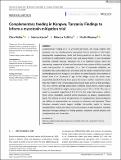| dc.description.abstract | Complementary feeding of 6- to 24-month-old infants and young children with adequate, safe and developmentally appropriate food is essential to child health. Inappropriate complementary foods and feeding practices are linked to the high incidences of undernutrition among infant and young children in most developing countries, including Tanzania. Mycotoxin risk is an additional concern, given the documented presence of aflatoxin and fumonisin in food systems of Africa, especially maize and groundnut. In preparation for a trial of mycotoxin mitigation, we conducted focus group discussions and recipe trials to explore complementary foods and feeding practices in Kongwa, a rural district of central Tanzania. Sixty mothers of infants from 6 to 18 months of age in five villages across the district were purposefully sampled. During focus group discussions, mothers reported to mostly feed their children with cereal and groundnut-based foods as thin or thick porridges. The most common porridge preparations contained cereal (mostly, maize) ranging from 66.7% to 80.0% by weight and groundnuts from 7.7% to 33.3%. The ratio of cereal to groundnut ranged from 3:1 to 4:1. For the recipe trial sessions, mothers chose similar ingredients reported during discussions to prepare complementary foods. The reliance on maize and groundnuts in complementary foods predisposes the children to undernutrition and exposure to aflatoxins and fumonisins. These formative research results suggest multiple intervention points to improve complementary feeding and reduce mycotoxin exposure in this population, including education messages package on feeding practices, mycotoxin control practices and complementary food formulation. | en_US |

